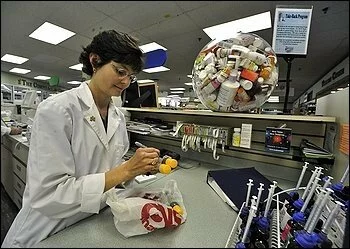Feds must make it easier to set up prescription drug take-back programs

We’ve written previously about FDA guidelines for proper disposal of prescription drugs. But with so many discarded medications winding up in landfills and, worse, the water supply, the best solution is no longer flushing drugs or throwing them away. It’s turning them in to prescription drug take-back programs in your community.
The problem, as the Washington Post reports, is that these programs are difficult to set up and maintain — thanks to government restrictions, among other factors.
According to the Post:
In much of the country … drug take-back sites … are almost impossible to find … “We are farther ahead with recycling our garbage than we are with recycling drugs,” said Babs Buchheister, the nursing director of Calvert County.
A major hurdle in any take-back program is what to do with controlled substances — for example, morphine — which constitute about 10 percent of all prescription medications in this country. Under Drug Enforcement Administration rules, a third party — beyond the patient and pharmacist — may not legally have possession of such drugs.
Thus, a family member or caregiver cannot return an unused portion of a controlled substance to a take-back program on the patient’s behalf. And any take-back program must have a DEA-registered representative — a pharmacist or a law enforcement officer — present to accept the drug.
Fortunately, a bill has been introduced in Congress that would make take-back programs easier to create and administer. The Safe Drug Disposal Act, introduced by Rep. James P. Moran Jr. (D-Va.) and co-sponsored by Rep. Jay Inslee (D-Wash.), is designed to encourage state take-back programs. Among its provisions, the bill would permit caregivers to turn over regulated drugs for disposal at DEA-approved, government-run sites.
This legislation is much needed — particularly when you consider that:
- the average American takes more than 12 prescription drugs annually, with more than 3.8 billion prescriptions purchased each year;
- 19 million tons of active pharmaceutical ingredients are dumped into the nation’s waste stream every year; and
- the EPA has identified more than 100 pharmaceuticals and personal-care products in the nation’s drinking water, including antibiotics, steroids, hormones and antidepressants.
We’ve added a button in our blog’s sidebar to show our support for SMARxT DISPOSAL, an initiative by the U.S. Fish & Wildlife Service and the pharmaceutical industry to encourage the safe, environmentally responsible disposal of prescription drugs.
We’re hoping that at some point, SMARxT DISPOSAL will add a nationwide list of drug take-back programs to its Web site.







-
-
Search Blog Posts
-
Save Even More Money!
-

-
Trending Content
-
Watch our YouTube Video
-
Categories
Big Pharma Buy prescriptions online Canadian drugs Drug costs Drug reimportation Drug safety eDrugSearch.com FDA Health 2.0 Healthcare100 Healthcare blogs Healthcare solutions Low-cost drugs Medicare Part D Merck Online pharmacies Online pharmacy safety Pfizer Pharma bloggers Pharmaceutical companies Pharmaceutical marketing Pharma cheerleaders Prescription drug abuse Prescription drug prices Prescription drugs Prescriptions Wal-Mart drug plan -
Blogroll
- Bullet Wisdom
- Bulverde Business Directory
- Christian Counseling San Antonio Tx.
- Christian Schools in San Antonio Texas
- Christian Social Network
- Christians United for Israel
- DrugWonks.com
- Eye on FDA
- GoozNews
- Health 2.0
- Hunting Forum
- In the Pipeline
- Jesus Christ Our King
- John Hagee Ministries
- Kevin, M.D.
- Local Search Marketing
- My $299 Website
- Pharm Aid
- Pharma Marketing
- PharmaGossip
- Pharmalot
- San Antonio Asphalt
- San Antonio Life Insurance
- San Antonio Pressure Washing
- Storage New Braunfels Tx
- Texas Wildlife Supply
- The Angry Pharmacist
- The Health Care Blog
- The Peter Rost Blog
- World Vision
-
Tags
big pharma Canadian drugs canadian pharmacies canadian pharmacy consumer reports craig newmark divine healing Drug costs drug prices Drug reimportation eDrugSearch.com FDA Fosamax Generic drugs healing scriptures Health 2.0 healthcare reform Hypertension Jehova Rophe Jesus Christ Lipitor Metformin miracles nabp online pharmacy dictionary online prescriptions osteoporosis peter rost Pharmacies pharmacists pharmacychecker pharmacy spam phrma Prescription drugs prescription medication Proverbs 3:5-8 reimportation relenza Roche saving money SSRI swine flu Tamiflu The Great Physician The Lord our Healer -
Recent Tweets
- eDrugSearch Blog Rank on the Healthcare100: http://t.co/VJprL4LZWl [#]
- New blog posting, How to Get Prescription Medication Without Health Insurance - http://t.co/1ZdLavB87d [#]
- 10 Tips for Safer Prescription Drug Use http://t.co/GFnMIN1mCy [#]
- New blog posting, How to Beat High Drug Prices By Comparing Low Cost Pharmacies - http://t.co/fsZ0stNZme [#]
-
Archives
-
Recent Comments
- Heather Sturges on What is the Difference Between Effexor and Cymbalta?
- Lupe Machol on Cost of diabetes drugs has nearly doubled
- Manpower For Hospital In Pune on Why is Medicine Cheaper in Canada?
- Jen on How a Canadian Pharmacy Can Help You Offset Drug Price Hikes
- nino iarajuli on Vending machine dispenses prescription drugs